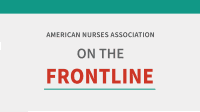Ryan Shaw knows the future starts now.
Ryan J. Shaw, PhD, RN, serves on the American Nurses Association (ANA) Innovation Advisory Board, which provides strategic guidance and thought leadership for developing and executing innovation strategy for the ANA Enterprise. Shaw is an associate professor at the Duke University School of Nursing and director of their Health Innovation Lab, an accelerator to test new technologies and care delivery processes in both real and simulated clinical environments. A North Carolina Nurses Association member, he describes how nursing leadership is essential to maximizing the potential of care delivery innovation.
What can nurse leaders do to challenge their strategic thinking?
Staying ahead of healthcare delivery changes and current trends can help nurse leaders determine where to allocate time and resources. It’s crucial to recognize the strengths, weaknesses, and opportunities of any proposed initiative.
In my field, digital health, we’ve been watching the rise of generative artificial intelligence (AI) integration into electronic health records (EHRs), which is becoming a bigger part of nursing care. AI can automate documentation and identify patterns in structured and unstructured clinical data, like notes. Although telehealth use has decreased since the pandemic’s early days, it remains a valuable tool in certain care models, such as mental health, and sustainable payment models support it. Strategic planning can optimize these advantages.
Conversely, discerning what might be a fleeting or unsustainable trend is equally essential. Consider virtual reality (VR). While promising for clinical education or surgical applications, it’s still quite costly. Moreover, a patient who is unwell may not want to wear a VR headset. This doesn’t dismiss its potential benefits, but any investments and applications in VR must be judicious.
What role does leadership play in innovation?
Leaders are instrumental in fostering both top-down and bottom-up innovation within an organization. Nurses should be given the time, autonomy, and resources to devise and share innovative processes that enhance patient care or efficiency. Incentives might be necessary to spur innovation, along with a conducive environment to iterate and learn from mistakes. However, given the ongoing nursing shortage and the unpredictable return on investment, dedicating resources can be a challenge. Leaders can champion bottom-up innovation by cultivating a culture that appreciates creativity and fresh perspectives, and values diverse thinking. Encouraging open communication and solution-sharing is key.
How can the growing digital health infrastructure become a tool for new care delivery models?
Digital health is shaping healthcare and the healthcare delivery system. The pandemic hastened the embrace of technology-driven healthcare, including telehealth, digital health tools, and AI-guided care. Telehealth improves access to care and expands the pool of available clinicians and appointments, notably in specialized fields like dermatology or mental health. Remote monitoring technologies and mobile apps feed real-time data into EHRs directly from patients’ daily environments, providing a comprehensive view of symptoms, biomarkers, and overall health. This influx of data is comparable to that generated in intensive care units. AI will play a critical role in deciphering this data abundance by identifying patterns, enabling nurses to deliver timely care and proactively prevent adverse clinical outcomes.
What are your hopes for nursing innovation in the next decade?
I hope that nurses will be at the table actively participating in creating creating innovative healthcare solutions. By pooling our collective ideas and experiences, nurses can contribute to equitable solutions that enhance patient and community outcomes and streamline healthcare delivery. Nurses should advocate for their roles, while leaders should provide opportunities for nurses and all clinicians to innovate.
Interview by Elizabeth Moore, content creator for ANA.
American Nurse Journal. 2023; 18(11). Doi: 10.51256/ANJ112341




















